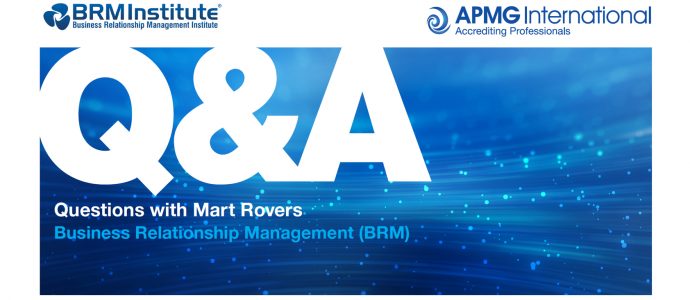The Evolution of Business Relationship Management (BRM) as Both A Capability and Role

Republished with permission from APMG International.
We had an opportunity to sit down with Mart Rovers, President of InterProm USA Corporation and a leading IT service management consultant and trainer, about the evolution of Business Relationship Management (BRM) as both a capability and role.
Q: Can you tell us a bit about your background in IT service management?
A: I have been a consultant and trainer in ITSM for the past twenty-five years. Prior to that, I managed a support team and datacenter, and began the early adoption of ITIL best practices. I worked for companies such as Philips Telecommunications, Lucent Technologies, and AT&T, and was involved in several projects responsible for building and implementing solutions for configuration, incident and service, and change and release management.
I am a certified ISO/IEC 20000 Internal Auditor, hold the ITIL® v3 Expert certification as well as the CBRM®, ISO/IEC 27001 Professional and Internal Auditor certifications and am an accredited instructor for ISO/IEC 20000, ISO/IEC 27001, BRM, COBIT® and ITIL training courses.
Q: Where did the role of Business Relationship Management first come from? Was it introduced in ITIL v3 Service Strategy, or ISO/IEC 20000?
A: Actually, BRM was introduced in the first version of ITIL. In 1990, the Central Computer and Telecommunications Agency, who then owned ITIL, published a book called Customer Liaison. This publication provided guidance on how to plan, implement and manage effective liaison between providers of IT services and the customers of these services, and to explain the importance of effective liaison in the provision of quality IT services. The book approached customer liaison more from a role perspective than a capability.
In 2004, the UK Office of Government Commerce, who owned ITIL at that time and as part of the second version of ITIL, published a book entitled Business Perspective: The IS View on Delivering Services to the Business. It addressed the BRM role as well as the capability quite well if I may say so. Interesting though was that in 2006, the OGC published Business Perspective: The Business View on Successful IT Service Delivery in which BRM was never referenced. Instead, it focused more on the governance of IT.
None of the ITIL publications referenced so far became hugely popular as most organizations adopting ITIL’s best practices at that time prioritized operational and tactical concerns over strategic improvement opportunities. This focus shifted when ITIL v3 was introduced in 2007 with ITIL Foundation courses that included addressing the BRM process and the BRM role as part of the Service Strategy phase of its service lifecycle.
The BRM role is also part of the ISO/IEC 20000-1 standard which came out in late 2005. Ever since, I have noticed that more and more organizations have introduced the BRM role.
Q: In your experience, did customers adopt that role in their organizations? How effective was it in converging IT and business?
A: Looking back at the early adopters of this role, it was mainly initiated by the IT organization and more often than not, the BRMs had an IT background rather than a business background. BRMs mainly operated as what we now call Order Takers or Service Partners. It is safe to say that IT was better positioned to align with the business because of this role and capability. However, this alignment had more characteristics of a one-way alignment than of a mutual one or converged. Certainly “demand shaping” was not a topic on a leadership’s meeting agenda. One must crawl before one walks and walk before one runs, right?
Q: What were the shortcomings in the role as defined in ITIL and ISO/IEC 20000?
A: While both ITIL and ISO/IEC 20000 have described the role quite well from an ITSM point of view, in my opinion, more attention could have been given on the business partner’s perspective on this role. That is not to say that either one ignores this point of view. However, more substance is often needed when seeking guidance on how to successfully implement this role at a strategic level in the organization, something that ultimately both ITIL and ISO/IEC 20000 hint towards.
Q: What made you interested in contacting Business Relationship Management Institute (BRM Institute)? What did you find appealing about what they offered?
After speaking with BRM Institute, it didn’t take long to make the decision to become a Professional Member, a Registered Provider and become an active participant in the global BRM Institute community. BRM Institute has so much to offer to organizations.
A: I learned about BRM Institute a few years ago through one of my customers. After speaking with BRM Institute, it didn’t take long to make the decision to become a Professional Member, a Registered Provider and become an active participant in the global BRM Institute community. BRM Institute has so much to offer to organizations.
You sometimes wish that every business and IT leader would take just 30 minutes out of their busy schedule and check out BRM Institute. Their impressive BRM Interactive Body of Knowledge (BRMIBoK), their culture of sharing and giving back, and their deep passion for BRM as a role and a capability is an eye-opener for anyone seeking to make organizations in today’s digital age more successful.
Q: What were your reactions when you started to explore Business Relationship Management as defined by BRM Institute?
A: My first exposure to their BRM best practices actually took me back to the late 80s when I was first exposed to ITIL and learned the “ITSM language”. The new “BRM language” is a much-needed “add-on” for today’s organizations, moving IT beyond being a service provider to a true business leading peer with shared ownership of strategy and business results. BRM Institute introduces terminology and concepts that truly complement best practices as captured in frameworks such as ITIL, COBIT, and ISO/IEC 20000.
I couldn’t wait to share them with my customers who have already implemented BRM practices. And, I wasn’t surprised by the immediate interest they expressed. The knowledge BRM Institute has captured and is making available is very rich. Their website is packed with quality and useful information. It makes it easier for a trainer and consultant or coach to help your customers when having readily access to this.
Q: Has the role extended beyond IT into other business functions? How do you think this will benefit the enterprise?
A: I really like this question. Yes, indeed, BRM, both as a capability and role most certainly extend beyond just IT. Other business functions such as Finance, Legal, Procurement, and Human Resources could and should benefit from the BRM capability and role. We have seen this trend on the tooling side with what were ITSM tools originally and that have now become enterprise management tools. The same can be said of certain frameworks that no longer speak of “IT” Service Management, but have stripped the “IT” portion and only speak of Service Management. The same happened with the ISO/IEC 20000 standard. The 2011 version does not reference IT any longer.
It is just a matter of time until the success stories make the headlines and the urge of “me too” hits a certain threshold. BRM Institute has HR Business Partners as members and defines a BRM capability as a capability that converges cross-functional teams and eliminates value-depleting organizational silos. It strengthens collaboration and drives a culture of creativity, innovation, and shared ownership across the enterprise, so that holistic, innovative, and value-driven strategies are created and deliver their intended business value results.
Q: Have you noticed differences in business outcomes between those companies who adopted the BRM and those who didn’t?
A: Most certainly! Even today, I am still working with customers who practice BRM on an ad hoc basis and where the CIO takes on most of the BRM responsibilities. Needless to say, firefighting is the norm in those organizations and the business perception of IT is low. There is no clarity, and valuable resources are wasted on rework and correcting mistakes.
The moment you see leadership trying to wrap their arms around what’s going on in their organization is when you see them introducing BRM, or at least prioritize communication about business and IT strategy over operational and tactical talk.
Q: What would your recommendation be to companies who are looking to implement BRM in their organization? What would you say about enterprise awareness, staffing, training, etc.?
A: I recommend taking an inventory of the BRM activities that are actually already in place, most likely in an informal way. Such self-assessment will be easier after sending a few team members to a BRMP Foundation course and becoming a Professional Member of BRM Institute to have access to their materials. The alternative would be to invest in an assessment.
After taking a closer look at your current BRM practices, a decision should be made as to what’s next. What is the expected value of having dedicated team members taking on the BRM role? Who is on the team who could grow into this dedicated role? What are the responsibilities and the level of authority of the BRM(s)? What are the improvements that need to be worked on first?
Q: What would you say to those companies who are not looking at BRM in their organizations? Is this something that they should explore?
These are just a few examples of how BRM can unleash the organization’s potentials and drive and ensure business value.
A: When your organization has adopted ITIL and/or COBIT best practices for example, but has never considered adopting BRM practices, I encourage them to spend an hour or two and read up on what these best practices frameworks have to say about BRM. Or, do a search on the Internet and see what some research firms have published. And if you would like to speak to somebody about this topic, contact BRM Institute or one of its members to chat about why you should invest and introduce this capability and role. And, I would be happy to provide some recommendations.
Introducing BRM, as BRM Institute defines it, helps shift the organization’s focus. It sends a message that leadership is serious about what each business unit brings to the table to make the overall organization perform at its best. Too often, people are not being heard in organizations; people with fantastic ideas, people who want to do what is right, and people who care for the organization’s clients and customers. These are just a few examples of how BRM can unleash the organization’s potentials and drive and ensure business value.

Special Credits to Mart Rovers, President of InterProm USA Corporation.

APMG International is a global accreditation and certification body. APMG administers a range of professional assessment, development and certification schemes in key management disciplines including Business Relationship Management, PMD Pro – Project Management for NGOs and IACCM Contract and Commercial Management.
APMG works with strategic partners to provide access to best practice guidance, training and certification to help individuals and their organizations deliver positive results and change through improved efficiency and performance www.apmg-international.com

Mart – finally took a few minutes to read this, and appreciated it so much. Great context and background on how you’ve seen the BRM journey. While I understood some of this before, I’m now even better equipped to talk some of the history, and really enjoyed hearing your perspectives of the importance of BRM moving forward. Thanks for taking the time on this.